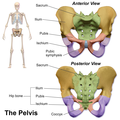Pubic symphysis
Pubic symphysis is a cartilaginous joint that is located between the left and right pubic bones near the front of the pelvis. This joint is covered by a thin layer of hyaline cartilage on the surface of the bones, which is in turn covered by a thick fibrocartilaginous disk.
Anatomy[edit]
The pubic symphysis is located approximately 1 cm above the urethra in men and above the vagina in women. It is a secondary cartilaginous joint, which means it is a joint that is both fibrous and cartilaginous. The joint is stabilized by a network of ligaments, including the superior pubic ligament, the inferior pubic ligament, and the anterior and posterior pubic ligaments.
Function[edit]
The primary function of the pubic symphysis is to absorb shock and allow slight movement between the left and right pubic bones. This slight movement is especially important during childbirth, as it allows the pelvis to expand slightly and facilitate the passage of the baby through the birth canal.
Clinical significance[edit]
Conditions that can affect the pubic symphysis include osteoarthritis, pubic symphysis diastasis, and osteitis pubis. Osteoarthritis of the pubic symphysis, which is a form of degenerative joint disease, can cause pain and limited movement. Pubic symphysis diastasis is a condition in which the pubic symphysis widens too much; this can occur during childbirth or due to trauma. Osteitis pubis is a condition characterized by inflammation of the pubic symphysis and surrounding muscle and can be caused by trauma, surgery, or strenuous activities.
See also[edit]
-
Anatomy of the pubic symphysis
-
Diagram of the skeletal pelvis showing the pubis
-
Illustration of the pelvis
-
Detailed anatomy of the pubic symphysis
-
Lateral view of the pubic symphysis
-
Pubic symphysis
Ad. Transform your life with W8MD's Budget GLP-1 injections from $75


W8MD offers a medical weight loss program to lose weight in Philadelphia. Our physician-supervised medical weight loss provides:
- Weight loss injections in NYC (generic and brand names):
- Zepbound / Mounjaro, Wegovy / Ozempic, Saxenda
- Most insurances accepted or discounted self-pay rates. We will obtain insurance prior authorizations if needed.
- Generic GLP1 weight loss injections from $75 for the starting dose.
- Also offer prescription weight loss medications including Phentermine, Qsymia, Diethylpropion, Contrave etc.
NYC weight loss doctor appointmentsNYC weight loss doctor appointments
Start your NYC weight loss journey today at our NYC medical weight loss and Philadelphia medical weight loss clinics.
- Call 718-946-5500 to lose weight in NYC or for medical weight loss in Philadelphia 215-676-2334.
- Tags:NYC medical weight loss, Philadelphia lose weight Zepbound NYC, Budget GLP1 weight loss injections, Wegovy Philadelphia, Wegovy NYC, Philadelphia medical weight loss, Brookly weight loss and Wegovy NYC
|
WikiMD's Wellness Encyclopedia |
| Let Food Be Thy Medicine Medicine Thy Food - Hippocrates |
Medical Disclaimer: WikiMD is not a substitute for professional medical advice. The information on WikiMD is provided as an information resource only, may be incorrect, outdated or misleading, and is not to be used or relied on for any diagnostic or treatment purposes. Please consult your health care provider before making any healthcare decisions or for guidance about a specific medical condition. WikiMD expressly disclaims responsibility, and shall have no liability, for any damages, loss, injury, or liability whatsoever suffered as a result of your reliance on the information contained in this site. By visiting this site you agree to the foregoing terms and conditions, which may from time to time be changed or supplemented by WikiMD. If you do not agree to the foregoing terms and conditions, you should not enter or use this site. See full disclaimer.
Credits:Most images are courtesy of Wikimedia commons, and templates, categories Wikipedia, licensed under CC BY SA or similar.
Translate this page: - East Asian
中文,
日本,
한국어,
South Asian
हिन्दी,
தமிழ்,
తెలుగు,
Urdu,
ಕನ್ನಡ,
Southeast Asian
Indonesian,
Vietnamese,
Thai,
မြန်မာဘာသာ,
বাংলা
European
español,
Deutsch,
français,
Greek,
português do Brasil,
polski,
română,
русский,
Nederlands,
norsk,
svenska,
suomi,
Italian
Middle Eastern & African
عربى,
Turkish,
Persian,
Hebrew,
Afrikaans,
isiZulu,
Kiswahili,
Other
Bulgarian,
Hungarian,
Czech,
Swedish,
മലയാളം,
मराठी,
ਪੰਜਾਬੀ,
ગુજરાતી,
Portuguese,
Ukrainian






